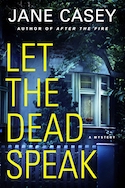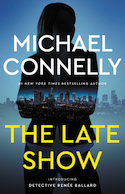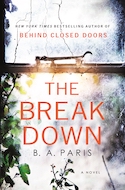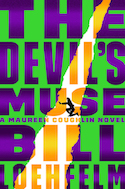Criminal Fiction: leaving out the parts that the readers skip
Every month, Daneet Steffens uncovers the latest goings on in mystery, suspense, and crime fiction. See previous columns on the Criminal Fiction archive page
A gleeful moment catching a fictional private investigator in the act of comfort-reading an Elmore Leonard novel had me rushing off to re-visit this fun guide to writing. From "Never open a book with weather," all the way to "Try to leave out the part that readers tend to skip," and with a loving nod to the power of hooptedoodle, Leonard’s teasing, detailed advice is pure pleasure.
Reading around: new titles on the crime fiction scene
A car crash has crippled Jane Norton with severe amnesia and left her passenger, David Hall, very much dead in Blame by Jeff Abbott (Grand Central). A note, found on the scene, indicated a suicide attempt on Jane’s part that apparently went horribly wrong. As the book opens, on the second anniversary of the crash, a new note turns up and Abbott’s perfectly-paced thriller catches literary fire, crackling along with a nicely-meshed Jason Bourne-I Know What You Did Last Summer vibe. With Jane’s memory full of gaping holes — she remembers her favorite books, from A Wrinkle in Time to the magical reads of Edward Eager and Lloyd Alexander, but blanks on the accident — we’ve got a literal unreliable narrator on our hands. Abbott, a deft and nimble writer, skillfully steers us through small-community pettinesses and pressures, as well as, yes, the dark evil that lurks — all too often, it seems — deep in suburban territory.

London detective Maeve Kerrigan is back on the case in Let the Dead Speak by Jane Casey (Minotaur). A claustrophobically-short street provides the immersive setting for a bloody crime scene: there’s a profusion of blood, in fact, but the killer appears to have absconded with the corpse. Kerrigan and her team, including fresh meat Georgia Shaw who can’t quite land on Kerrigan’s good side, tangle with a sullen young man with a history of violence, two vulnerable teenage girls, and a family of evangelicals that includes a couple of brothers with some serious sibling rivalry issues. Kerrigan’s ability to home in on people’s deepest, most destructive qualities as well as their inevitable Achilles’ heels — “her trick of understanding more than she should,” as one character notes – keeps the tension level high. Kerrigan and her colleagues’ ability to banter about things like, say, the stability of eyeball fluid when it comes to sampling for the presence of drugs, keeps everything else grounded in grisly police procedural reality.

Michael Connelly adds the excellent Detective Renée Ballard to his stable of engaging protagonists in The Late Show (Little, Brown), and, thanks to Connelly’s concise and empathetic writing, Ballard arrives fully-formed, with a heady sense of familiarity about her. Ballard, recently relegated to the night shift (“the late show”) due to illicit politicking by another officer, chases up a credit card robbery, a near-fatal beating, and a “four on the floor” nightclub shooting, which all kick off over a busy night’s work and then overshadow her sleep-deprived days. In between her investigations, she tries to chill out with her paddleboard – there are canny surfing and journalism elements to her backstory – her loyal pooch and her loving grandmother, but much of the book’s blistering action is based around Ballard pursuing the baddies while fighting off some nasty colleagues who have it in for her. Detective Ballard is off to a winning start: she may be short of sleep, but she’s already a legend.

In The Breakdown by B.A. Paris (St. Martin’s), Cass’s apparent dream of a life deteriorates quite quickly when she notices a woman in a car on a lonely stretch of road, and then that woman turns up murdered. Cass has a wonderful husband, a fiercely loyal best friend and a supportive group of colleagues, but the unexpected death plays on her mind and her emotions. Exacerbating an already stressful situation is the fact that her mother died from early-onset dementia and — a fumbled BBQ date here, a slip of memory around a gift there — Cass quickly becomes convinced that she’s suffering from the same familial memory issues. Behind Closed Doors, Paris’s 2016 psychological thriller debut, was one of the more terrifying reads of the year; this follow-up isn’t quite as edgy, but it’s highly engaging nonetheless.
The Quintessential Interview: Bill Loehfelm

Bill Loehfelm’s New Orleans police officer, Maureen Coughlin, like Loehfelm himself, relocated from Staten Island to The Big Easy where she’s already gappled with high-level corruption as well as more general criminal activities. In The Devil’s Muse, out this month from Farrar, Straus and Giroux, and taking place over the course of a single, tension-tattered night bang-smack in the middle of NOLA’s Mardi Gras festivities, Coughlin has her patience tested by a documentary filmmaker, a nasty new street drug, a neighborhood shooting, and some of her more surly colleagues. Excellent stuff.
What or who are your top five writing inspirations?
I get a lot of inspiration from movies, actually. Both old favorites and something new that really kicks my ass, especially if it has killer dialog.
Songwriters, too. Someone like Jason Isbell, who I’ve been big into lately, can get a whole novel into a four-minute song. That amazes me. When I hear it done well, it makes me want to get to work. Every time I see my friend Kelcy Mae play music, songs that she wrote, I want to go home and write.
My wife, AC, is a great writer and an indefatigable worker. I always want to make sure I’m pulling my weight around the house.
Seeing other artists at the top of their game is always a challenge and inspiration.
And two weird stories I grew up with – Batman and King Kong. Something about those two stories, those two American myths, it’s like there’s something mystical I’m always trying to pull out of them.
Top five places to write?
The last few books I’ve written exclusively at home since I work on a desktop. We have a sunroom at the back of the apartment that works great as an office: it’s almost all windows, and we call it “the lighthouse.”
I take my editing on the road, though. I live in a coffee shop rich neighborhood and I can walk to a handful. My favorite is the Rue de la Course on Magazine Street, which, after a few misguided years as a restaurant, is a coffee shop again.
I like Mojo on the corner of Magazine and Race, too – which many years ago was the original Rue. There’s a cool place on Magazine called the Reservoir, but that’s more of a crepe place now.
Every now and then I hit HiVolt, but like a lot of the new school coffee shops, they close early.
Top five favorite authors?
Picking only five is impossible. Kate Atkinson is the first one that comes to mind. She’s a stone genius. Megan Abbott has done some of the best work of the last ten years that I’ve come across.
Donna Tartt is in a class by herself.
And JK Rowling has to be in there, too. I love her books as Robert Galbraith as well as that other thing she did. I’ll read anything she writes.
And Alice Sebold, too, who I always forget to mention when I make these lists. I’ve worked real hard to imitate her voice over the years. There’s just an edge that she has. I hope to God she writes another book.
Top five tunes to write to?
For the Maureen Coughlin books I lean a lot on local stuff: A small sample:
- “Criminal” — The Revivalists (I write to a lot of their material)
- “Ice Age” — Dr. John
- “Night People” — the Soul Rebels Brass Band
- “The Corner” — Galactic w/Gift of Gab
- “Power” — Juvenile (w/Rick Ross).
Top five hometown spots?
My screened-in porch.
Joey K’s, a restaurant in the neighborhood where we can get an outside table on the corner. I have lunch there almost every Tuesday with friends who are also self-employed artists.
Tipitina’s for live music any time of year.
The Fair Grounds, where they have Jazz Fest every spring – my high, holy season.
Audubon Park, especially the Tree of Life where I married my wife.